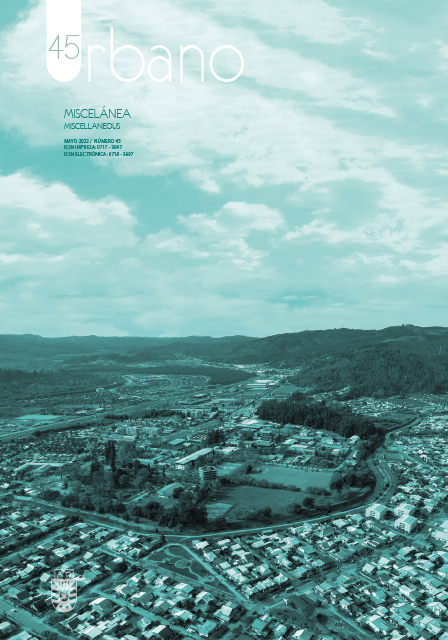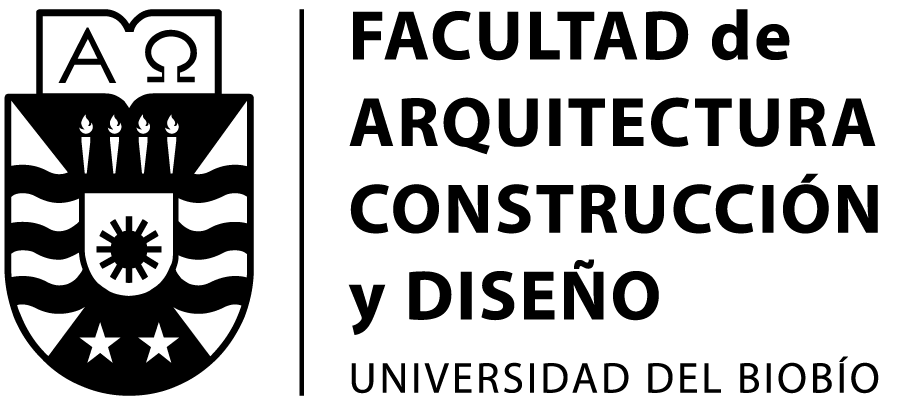Impacts of the immigration corridor on peruvian and chilean cities: urban transformations during the pandemic
DOI:
https://doi.org/10.22320/07183607.2022.25.45.01Keywords:
migration, covid-19, public spaces, urban transformationsAbstract
The eviction of migrants from Plaza Brasil, in the city of Iquique, an act that was questioned due to the violence used by public forces, revealed not just the humanitarian problem involved, but also a turning point in attempts to normalize a process where cities have been altered by the exodus of migrants. This study looks into the impacts generated by the successive stages of migration within the Venezuelan migratory flow, one characterized by the great vulnerability of these migrants. Since the start of 2020, amid a health crisis and border closures, they have entered Colombia, Ecuador, Peru, Bolivia, and Chile by land using unauthorized crossings, to find better living conditions in these destinations. Here, the approaches which connect flows and transformations as responses to reproduction factors of global society, with those that conceive mobility as a “creative force” that interacts autonomously with these structures, are discussed. To this end, mobility in the historical centers of three cities located in border transit and entry zones to each country, where the interrelation in public space has been transformed and stressed, is explored, namely Piura, in Peru, and Iquique and Antofagasta in Chile. The results show similarities in the dynamics and transformations generated. Given the vulnerable condition of migrants, there is an increase in the occupation of public space, through autonomous actions of self-management and organization, as well as local resistance, demonstrating the relevance of mobility in modern society. All-in-all, it is recommended to adopt a differentiated agenda to understand the connection between migrants and places during the mobility experience.
Downloads
References
BANKS, M. (2010). Los datos visuales en Investigación Cualitativa. Madrid: Ediciones Morata, S.L.
BOJADŽIJEV, M. y SERHAT, K. (2010). Recuperating the Sideshows of Capitalism: The Autonomy of Migration Today. e-flux Journal, (17). Recuperado de https://www.e-flux.com/journal/17/67379/recuperating-the-sideshows-of-capitalism-the-autonomy-of-migration-today/
BORJA, J. y MUXÍ, Z. (2003). El espacio público, ciudad y ciudadanía. Barcelona: Editorial Electa.
BORK-HUFFER, T., ETZOLD, B., GRANSOW, B., TOMBA, L., STERLY, H., SUKA, K. y FLOCK, R. (2014). Agency and the Making of Transient Urban. Population, Space and Place, 22(2). DOI: https://doi.org/10.1002/psp.1890
CANALES, A. (2013). La migración en la reproducción de la sociedad global. Migración y desarrollo, 11(21), 09-41. Recuperado de http://www.scielo.org.mx/scielo.php?script=sci_arttext&pid=S1870-75992013000200002&lng=es&tlng=es.
CANALES, A. (2016). La migración en la reproducción de la sociedad. Elementos para una teoría de las migraciones. En Canales, A. (Coord.), Debates contemporáneos sobre migración internacional. Una mirada desde América Latina (21-63). México: Universidad de Guadalajara.
CARRIÓN, F. (2007). Espacio público: punto de partida para la alteridad. En Segovia, O. (Ed.), Espacios públicos y construcción social. Hacia un ejercicio de ciudadanía (pp.79-97). Santiago de Chile: Ediciones SUR.
CASAS-CORTÉS, M. (2020). La autonomía de la migración: Una perspectiva alternativa sobre la movilidad humana y los controles migratorios. EMPIRIA. Revista de Metodología de Ciencias Sociales, (46), 65-92. DOI: empiria.46.2020.2697
DATTA, A. y BRICKELL, K. (2011). Translocal Geographies: Spaces, Places, Connections. Farnham: Ashgate.
DE CERTAU, M. (1999). La invención de lo cotidiano. México: Universidad Iberoamericana/ITESO/Centro Francés de Estudios Mexicanos y Centroamericanos.
El Comercio (15 abril 2018). ¿Cuál es la situación de los venezolanos en las regiones? Recuperado de https://elcomercio.pe/peru/situacion-venezolanos-regiones-noticia- 511858-noticia/
ESCOBAR LA CRUZ, R. (2019, June 25). Los ‘panas’ que vienen. El país. Recuperado de https://elpais.com/elpais/2019/06/24/migrados/1561370637_128671.html
ETZOLD B., KECK M., BOHLE H. G. Y ZINGEL, W. P. (2009). Informality as agency. Negotiating food security in Dhaka. Die Erde, (140), 3–24.
ETZOLD, B. (2019). Migrants Turn Cities at the Crossroads into ‘Transient Urban Spaces’. Understanding the relations between migration, translocality, and urban transformations. Research Group Transient Spaces & Societies. DOI: https://doi.org/10.34834/2019.0005
FLICK, U. (2012). Introducción a la investigación cualitativa. Madrid: Ediciones Morata.
GARCÍA-ARIAS, M. F. y HERNÁNDEZ-PILGARÍN, G. (2019). Obsolescencia y revitalización de un parque. Acción colectiva, cognición y ciudadanía en la apropiación del espacio público. Revista Eleuthera, 20, 55–72.
DOI: https://doi.org/10.17151/eleu.2019.20.4.
Instituto Nacional de Estadística e Informática [INEI] (2018). Producción y Empleo Informal en el Perú. Recuperado de https://www.inei.gob.pe/media/MenuRecursivo/publicaciones_digitales/Est/Lib1589/
JOHNSON, A. J. y GLOVER, T. D. (2013). Understanding Urban Public Space in a Leisure Context. Leisure Sciences, 35(2), 190–197. DOI: https://doi.org/10.1080/01490400.2013.761922
KOHN, M. (2004). Brave new neighborhoods: the privatization of public space. New York: Routledge.
LEFEBVRE, H. (2013). La producción del espacio. Madrid: Capitan Swing.
MALDONADO, C., MARTÍNEZ PIZARRO, J., MARTÍNEZ, R. (2018). Protección social y migración. Una mirada desde las vulnerabilidades a lo largo del ciclo de la migración y de la vida de las personas. Comisión Económica para América Latina y el Caribe (CEPAL). Documentos de Proyectos. Santiago: Naciones Unidas.
MASSÓ GUIJARRO, E. (2013). Overcoming methodological nationalism: Cosmopolitan communities of interaction in the Lavapiés neighborhood. Migraciones Internacionales, 7(2), 71–100. DOI: https://doi.org/10.17428/rmi.v7i25.697
MITCHELL, D. (2003). The Right to the City: Social Justice and the Fight for Public Space. New York: The Guilford Press.
Organización Internacional para las Migraciones [OIM] (2020). Monitoreo de flujo de población venezolana en el Perú. Recuperado de https://www.unicef.org/peru/media/6361/file/DTM 7 - Datos sobre población venezolana en Perú.pdf
PRICE, M. y CHACKO, E. (2012). Migrants’ Inclusion in Cities. Innovative Urban Policies and Practices. New York: UN-Habitat y UNESCO.
RIVERO, P. J. (2017). La investigación multilocalizada en los estudios migratorios transnacionales. Aportes teóricos y prácticos. Trabajo y sociedad, (28), 327–342.
ROY, A. y ALSAYYAD, N. (Eds.) (2004). Urban Informality. Transnational Perspectives from the Middle East, Latin America and South Asia. Lexington Books: Oxford.
RUIZ, J. I. (2012). Metodología de la investigación cualitativa. Bilbao: Universidad de Deusto.
SANTOS, M. (1996). De la totalidad al lugar. Barcelona: Oikos-tau.
SANTOS, M. (2004). Por otra globalización. Del pensamiento único a la conciencia universal. Bogotá: Ediciones Convenio Andrés Bello.
SILVEIRA, M. (2014). Geografía y formación socioespacial: por un debate sustantivo. Estudios Socioterritoriales. Revista de Geografía, 2(16), 141-168. Recuperado en: https://ojs2.fch.unicen.edu.ar/ojs-3.1.0/index.php/estudios-socioterritoriales/article/download/592/546
WITTMER, E. (2017). Aménager les espaces publics - Mettre en place le processus - Portail territorial. París: Territorial Éditions.
ZUKIN, S. (1995). The cultures of cities. Cambridge: Blackwell.
Downloads
Published
How to Cite
Issue
Section
License
Copyright (c) 2022 Alberto Prado Díaz, Stella Schroeder, Claudio Cortes

This work is licensed under a Creative Commons Attribution-ShareAlike 4.0 International License.
The content of articles which are published in each edition of Habitat Sustentable, is the exclusive responsibility of the author(s) and does not necessarily represent the thinking or compromise the opinion of University of the Bio-Bio.
The author(s) conserve their copyright and guarantee to the journal, the right of first publication of their work. This will simultaneously be subject to the Creative Commons Recognition License CC BY-SA, which allows others to share-copy, transform or create new materials from this work for non-commercial purposes, as long as they recognize authorship and the first publication in this journal, and its new creations are under a license with the same terms.![]()























